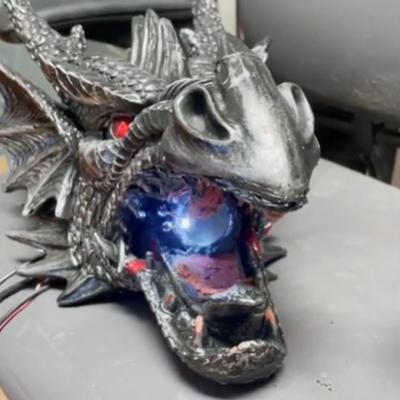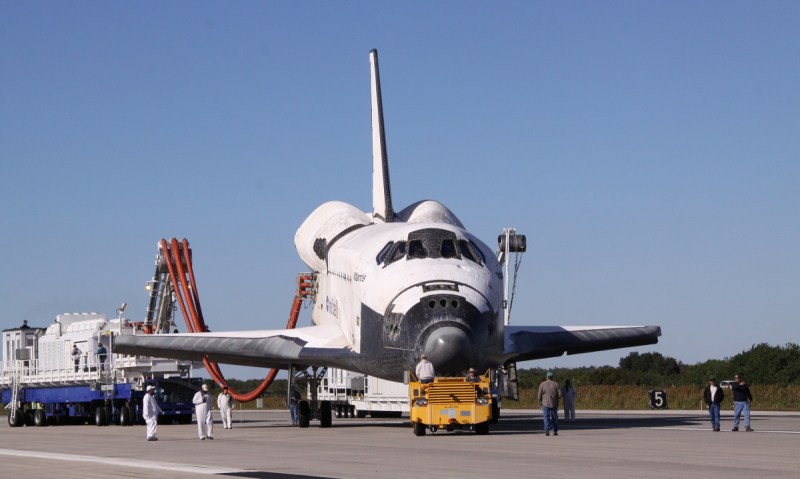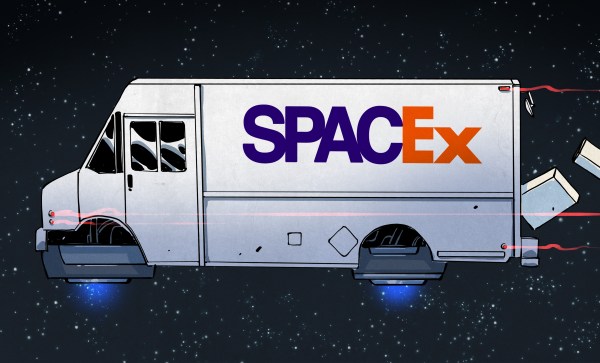It’s been a while since we’ve dunked on an autonomous taxi foul-up, mainly because it seemed for a while there that most of the companies field testing driverless ride-sharing services had either ceased operation or curtailed them significantly. But that appears not to be the case after a Waymo robotaxi got stuck in a Chick-fil-A drive-through. The incident occurred at the chicken giant’s Santa Monica, California location at about 9:30 at night, when the autonomous Jaguar got stuck after dropping off a passenger in the parking lot. The car apparently tried to use the drive-through lane to execute a multi-point turn but ended up across the entrance, blocking other vehicles seeking their late-evening chicken fix. The drive-through-only restaurant ended up closing for a short time while Waymo figured out how to get the vehicle moving again.
dragon21 Articles
Hackaday Links: March 30, 2025
The hits just keep coming for the International Space Station (ISS), literally in the case of a resupply mission scheduled for June that is now scrubbed thanks to a heavy equipment incident that damaged the cargo spacecraft. The shipping container for the Cygnus automated cargo ship NG-22 apparently picked up some damage in transit from Northrop Grumman’s Redondo Beach plant in Los Angeles to Florida. Engineers inspected the Cygnus and found that whatever had damaged the container had also damaged the spacecraft, leading to the June mission’s scrub.
Mission controllers are hopeful that NG-22 can be patched up enough for a future resupply mission, but that doesn’t help the ISS right now, which is said to be running low on consumables. To fix that, the next scheduled resupply mission, a SpaceX Cargo Dragon slated for an April launch, will be modified to include more food and consumables for the ISS crew. That’s great, but it might raise another problem: garbage. Unlike the reusable Cargo Dragons, the Cygnus cargo modules are expendable, which makes them a great way to dispose of the trash produced by the ISS crew since everything just burns up on reentry. The earliest a Cygnus is scheduled to dock at the ISS again is sometime in this autumn, meaning it might be a long, stinky summer for the crew.
Hackaday Links: March 23, 2025
What a long, strange trip it’s been for NASA astronauts Suni Williams and Bruce Wilmore, who finally completed their eight-day jaunt to space after 289 days. The duo returned to Earth from the ISS on Tuesday along with two other returning astronauts in a picture-perfect splashdown, complete with a dolphin-welcoming committee. For the benefit of those living under rocks these past nine months, Williams and Wilmore slipped the surly bonds way back in June on the first crewed test flight of the Boeing Starliner, bound for a short stay on the ISS before a planned return in the same spacecraft. Alas, all did not go to plan as their ride developed some mechanical difficulties on the way upstairs, and so rather than risk their lives on a return in a questionable capsule, NASA had them cool their heels for a couple of months while Starliner headed home without them.
There’s been a lot of talk about how Butch and Suni were “stranded,” but that doesn’t seem fair to us. Sure, their stay on the ISS was unplanned, or at least it wasn’t Plan A; we’re sure this is always a contingency NASA allows for when planning missions. Also unfortunate is the fact that they didn’t get paid overtime for the stay, not that you’d expect they would. But on the other hand, if you’re going to get stuck on a work trip, it might as well be at the world’s most exclusive and expensive resort.
Microsoft BASIC For The Dragon 64 Recovered
There are a great many pieces of software of yesteryear that are no longer readily accessible. It’s now possible to cross Microsoft BASIC for the Dragon 64 off that list, with the source code now posted for all to enjoy on GitHub.
The repository concerns the Microsoft 16K BASIC Interpreter as built for the Motorola 6809, as used in the Dragon 64 computer. This is also known as BASIC-69 or Extended Color Basic.
Hilariously, the source code was recovered from 340 pages of fan-fold tractor paper stored in four bundles. The output of a Motorola assembler was printed back in 1983 at Dragon Data’s R&D facility in Wales, and was recently recovered after being stored in an attic for much of the last four decades. The paper was carefully scanned at the 2022 Dragon Meetup, before passing the resulting images through OCR software. The output was then manually corrected and the source code was complete for both the 32K and 64K mode ROMs. There are some differences between the scanned source and what Microsoft shipped, which is outlined in the repository.
We’ve seen other heroic retrocomputer recovery efforts before, too, like the work to save the Polish CROOK OS. If you’ve been working on similar feats, be sure to let us know.
Flame-Spitting Dragon Head Heats Up Halloween
Halloween is looming, and [Jonathan Gleich] decided that an ideal centerpiece would be a flame-spitting dragon’s head. It started with an economical wall-mount dragon’s head, combined with a variety of off-the-shelf components to become something greater.

The fire comes from a kind of propane torch sold as a weed killer set, which looks a little like a miniature tiger torch. The flow of propane is limited by a regulator (which keeps the flame short and fixed), and controlled with a gas-rated 12 V solenoid valve. Ignition is done with the help of a spark igniter that fires up on demand, fed by a high-voltage ignition coil. The two combine at the Dragon’s mouth, where the flame originates, but the electrical components are otherwise isolated from the gas elements as much as possible.
The dragon head is made of acrylic, and if exposed to enough heat acrylic will first melt, then burn. To help avoid a meltdown, the dragon breathes fire only intermittently. [Jonathan] also gave the mouth area a heat-resistant barrier made from generous layers of flame-blocking mortar and sealants from the hardware store. The finishing touch comes in the form of bright red LEDs in the eyes, which give the head a bit more life.
Watch the ignitor in action and see the head spewing flames in the two short videos embedded below. The head should make for some good pictures come Halloween, and is a good example of how repurposing off-the-shelf items can sometimes be just what is needed for a project.
Interested in something smaller, but still fiery? Check out this pet fire-breathing dragon project for all your robotic animal companion needs. Continue reading “Flame-Spitting Dragon Head Heats Up Halloween”
Not All SpaceX Software Goes To Space
SpaceX has always been willing to break from aerospace tradition if they feel there’s a more pragmatic solution. Today this is most visible in their use of standard construction equipment like cranes in their Starship development facility. But the same focus on problem solving can also be found in their software parts we don’t see. Recently we got two different views behind the scenes. First, a four-part series about “software in space” published by StackOverflow blog, followed quickly by an Ask Me Anything (AMA) session on SpaceX Reddit.
Some of the StackOverflow series cover ground that has been previously discussed. Mostly in the first part dealing with their workhorse Falcon and Dragon vehicles, and some in the second part discussing Starlink whose beta program is reaching more and more people. Both confirmed that spaceflight software has to meet very stringent requirements and are mostly close to the metal bespoke C++ code. But we receive fascinating new information in part three, which focuses on code verification and testing. Here they leverage a lot of open source infrastructure more common to software startups than aerospace companies. The fourth and final component of this series covers software to support SpaceX hardware manufacturing, which had been rarely discussed before this point. (Unfortunately, there was nothing about how often SpaceX software developers copy and paste code from StackOverflow.)
The recent Reddit AMA likewise had some overlap with the SpaceX software AMA a year ago, but there were new information about SpaceX work within the past year. There was Crew Dragon’s transition from a test to an operational vehicle, and the aforementioned Starship development program. Our comments section had a lot of discussion about the practicality of touchscreen interfaces in real spacecraft, and here we learn SpaceX put a lot of study into building something functional and effective.
It also showed us that essentially every Sci-Fi Movie Interface was unrealistic and would be unreadable under extreme conditions.
In the course of this research, they learned a lot of pitfalls about fictional touch interfaces. Though to be fair, movie and television spacecraft UI are more concerned about looking cool than being useful.
If the standard AMA format is not to your liking, one of the contributors compiled all SpaceX answers alongside their related questions in a much more readable form here. And even though there’s an obvious recruiting side to these events, we’re happy to learn more about how SpaceX have continued to focus on getting the job done instead of rigidly conforming to aerospace tradition. An attitude that goes all the way back to the beginning of this company.
A New Era Of Spacecraft Delivers Science On Time
When the Space Shuttle Atlantis rolled to a stop on its final mission in 2011, it was truly the end of an era. Few could deny that the program had become too complex and expensive to keep running, but even still, humanity’s ability to do useful work in low Earth orbit took a serious hit with the retirement of the Shuttle fleet. Worse, there was no indication of when or if another spacecraft would be developed that could truly rival the capabilities of the winged orbiters first conceived in the late 1960s.
While its primary function was to carry large payloads such as satellites into orbit, the Shuttle’s ability to retrieve objects from space and bring them back was arguably just as important. Throughout its storied career, sensitive experiments conducted at the International Space Station or aboard the Orbiter itself were returned gently to Earth thanks to the craft’s unique design. Unlike traditional spacecraft that ended their flight with a rough splashdown in the open ocean, the Shuttle eased itself down to the tarmac like an airplane. Once landed, experiments could be quickly unloaded and transferred to the nearby Space Station Processing Facility where science teams would be waiting to perform further processing or analysis.

For 30 years, the Space Shuttle and its assorted facilities at Kennedy Space Center provided a reliable way to deliver fragile or time-sensitive scientific experiments into the hands of researchers just a few hours after leaving orbit. It was a valuable service that simply didn’t exist before the Shuttle, and one that scientists have been deprived of ever since its retirement.
Until now. With the successful splashdown of the first Cargo Dragon 2 off the coast of Florida, NASA is one step closer to regaining a critical capability it hasn’t had for a decade. While it’s still not quite as convenient as simply rolling the Shuttle into the Orbiter Processing Facility after a mission, the fact that SpaceX can guide their capsule down into the waters near the Space Coast greatly reduces the time required to return experiments to the researchers who designed them.
Continue reading “A New Era Of Spacecraft Delivers Science On Time”















